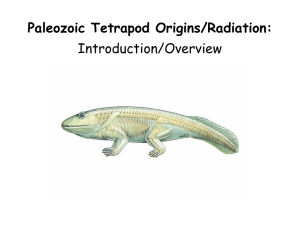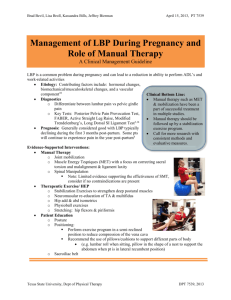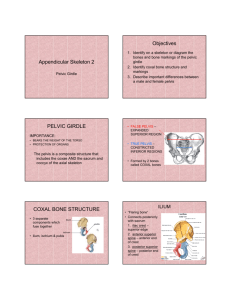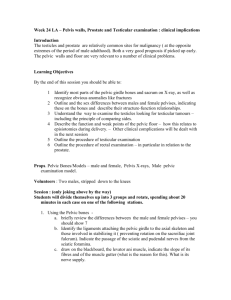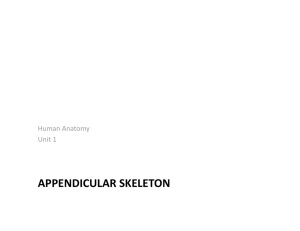Anatomy and Physiology of Human Movement
advertisement
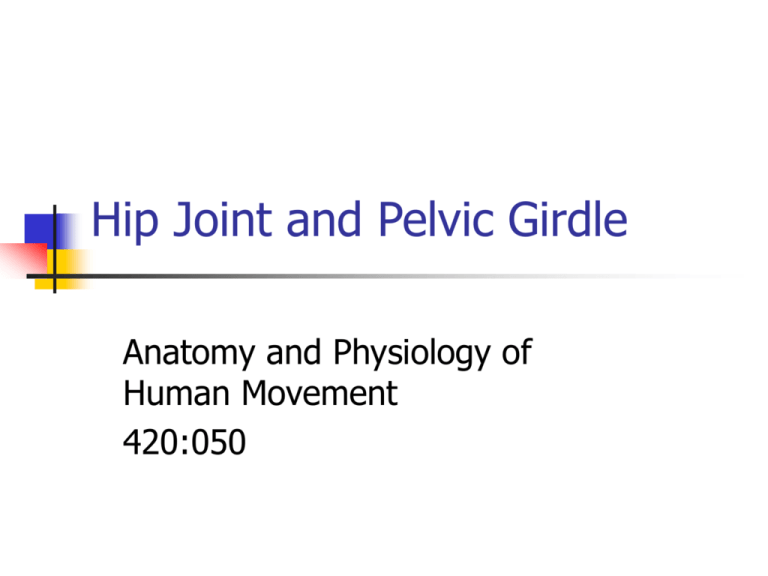
Hip Joint and Pelvic Girdle Anatomy and Physiology of Human Movement 420:050 Hip Joint and Pelvic Girdle Hip joint Acetabular femoral joint Pelvic girdle Pelvis Hip joint and pelvic girdle work together much like shoulder joint and girdle Several bones Pelvis moves in response to trunk and/or thigh movement Extremely stable joint Ligamentous structure Muscles Deep acetabulum Objectives 1. Be able to identify the bones of the hip joint and pelvic girdle 2. Be able to identify the hip joint, pelvic girdle, symphisis pubis and sacroiliac joints 3. Be able to identify the landmarks of the femur, pelvic bones and proximal tibia 4. Be able to identify and describe the movements of the hip joint and pelvic girdle 5. Be able to identify and describe the general attachments (distal/proximal), and movements of the hip joint and pelvic girdle Hip Joint and Pelvic Girdle Bones Femur Pelvic bones: Three sections (fused at maturity) Sacrum Ilium Ischium Pubis Extension of spine (5 fused verterbrae) Coccyx Pelvic girdle Pelvic bones, sacrum and coccyx Pelvic bones Femur Sacrum Coccyx Ilium Upper 2/5 Ischium Pubis Anterior/lower 1/5 Posterior/lower 2/5 Objectives 1. Be able to identify the bones of the hip joint and pelvic girdle 2. Be able to identify the hip joint, pelvic girdle, symphisis pubis and sacroiliac joints 3. Be able to identify the landmarks of the proximal femur and pelvic bones 4. Be able to identify and describe the movements of the hip joint and pelvic girdle 5. Be able to identify and describe the general attachments (distal/proximal), and movements of the hip joint and pelvic girdle Hip Joint and Pelvic Girdle Hip Joint Joint classification Multiaxial ball and socket Pelvic Girdle: Two joints 1. Symphisis pubis: Amphiarthrodial (cartilagenous) 2. Sacroiliac joints: Diarthrodial nonaxial Sacroiliac Joints Symphisis pubis Acetabular femoral joint Objectives 1. Be able to identify the bones of the hip joint and pelvic girdle 2. Be able to identify the hip joint, pelvic girdle, symphisis pubis and sacroiliac joints 3. Be able to identify the landmarks of the proximal femur and pelvic bones 4. Be able to identify and describe the movements of the hip joint and pelvic girdle 5. Be able to identify and describe the general attachments (distal/proximal), and movements of the hip joint and pelvic girdle Femoral and Pelvic Landmarks Head Neck Greater trochanter Lesser trochanter Gluteal tuberosity Lateral epicondyle Medial epicondyle Patella Ilium Anterior superior iliac spine Anterior inferior iliac spine Iliac crest Pubis Acetabulum Ischium Ischial tuberosity Obturator foramen Anterior Medial tibial condyle Lateral tibial condyle Fibular head Tibial tuberosity Objectives 1. Be able to identify the bones of the hip joint and pelvic girdle 2. Be able to identify the hip joint, pelvic girdle, symphisis pubis and sacroiliac joints 3. Be able to identify the landmarks of the proximal femur and pelvic bones 4. Be able to identify and describe the movements of the hip joint and pelvic girdle 5. Be able to identify and describe the general attachments (distal/proximal), and movements of the hip joint and pelvic girdle Hip Joint and Pelvic Girdle Movements Hip Joint: Multiaxial ball and socket Flexion/extension Abduction/adduction Circumduction Internal/external rotation Pelvic girdle: Anterior/posterior pelvic rotation/tilt Right/left lateral pelvic rotation/tilt Right/left transverse pelvic rotation/tilt Pelvic Girdle Movements Anterior pelvic rotation/tilt: Iliac crest tilts forward Sagittal plane Pelvic Girdle Movements Posterior pelvic rotation/tilt: Iliac crest tilts backward Sagittal plane Pelvic Girdle Movements Right lateral pelvic rotation/tilt: Right pelvis moves inferiorly in relation to left pelvis Lateral plane Opposite for left side Right or left? Pelvic Girdle Movements Right transverse pelvic rotation/tilt: Right iliac crest moves posteriorly in relation to the left iliac crest Transverse plane Opposite for left side Right or left? Movement Summary: Hip Joint: Multiaxial ball and socket F/E, Abd/Add, I/E rotation, Circ. Pelvic Girdle: Rotation in all three planes

